Walvisteuthis
Walvisteuthis rancureli
Stubby hooksquid
Richard E. Young, Michael Vecchione, and Kotaro TsuchiyaIntroduction
Walvisteuthis rancureli is a small squid of under 80 mm ML as an adult. This species is easily recognized by its short, broad shape and oval fins. Another diagnostic feature of Walvisteuthis species is the short, thin, blunt rostrum that is oriented perpendicular to the gladius.
The single recognized species has a very broad geographical distribution. The type locality is the tropical Indian Ocean. The junior synonym, Walvisteuthis virilis, was taken in the temperate South Atlantic. The specimens described here are from the tropical North Pacific, and we have seen specimens from the tropical Atlantic. Rancurel (1970) described specimens from the tropical South Pacific. For an onychoteuthid, this broad distribution suggests that "Walvisteuthis rancureli" probably represents a species complex. However, squid in present collections are insufficient to define possible species differences. This is partly due to the fact that nearly all squid have been recovered from the stomachs of fish. Acidity of the fish stomach will greatly damage the horny suckers and hooks. Because W. rancureli may represent a species complex, we include exerpts from the original descriptions of Onykia rancureli and Walvisteuthis virilis:
Diagnosis
An onychoteuthid ...
- Fins oval, not drawn-out posteriorly (unique character).
- with gladius visible beneath skin in dorsal midline.
- with 3 occipital folds.
Characteristics
- Arms
- Dorsal protective membranes of arms II and III greatly enlarged (ca. 2X) relative to their ventral protective membranes, and with long, well-defined trabeculae.
- Suckers lack distal fleshy knob (see Onychoteuthis).
- Tentacular club
- A few marginal suckers present in subadults, presumably lost in adults.
- Occipital region
- 3 occipital folds; large occipital membrane from fold 3 extends dorsally and curves to join occipital crest without forming a distict fourth fold. Olfactory organ lies at posterior end of fold no. 2.
- Head
- Beaks: Descriptions can be found here: Lower beak; upper beak.
- The margins of the funnel groove are straight and define a sharply pointed V-shape.
- Beaks: Descriptions can be found here: Lower beak; upper beak.
- Fins
- Oval with large anterior lobes; not drawn-out posteriorly (see Title illustration). The apical fin-angle is approximately 180°.
- Photophores
- Absent. Note, in the photograph above, that the eye which has popped outside the eyelid, has no photophores on its ventral surface.
- Gladius
- Short, blunt rostrum directed perpendicular to tip of gladius.
- Gladius visible in dorsal mid-line except at posterior tip of mantle.
Comments
The above description is based on specimens captured in Hawaiian waters.
Additional features of the description can be found here.
Nomenclature
Nesis and Nikitina (1986) described a new family of squids, "Walvisteuthidae", based on a mature male which they named Walvisteuthis virilis. The squid was somewhat similar to onychoteuthids but it had a number of very peculiar features that caused the authors to erect the new family. The peculiar features appear to be modifications that arise at sexual maturity. "Onykia" rancureli has been widely recognized as being very different from other members of this genus and several authors have suggested that a new generic name is needed (e.g., Toll, 1982; Tsuchiya and Okutani, 1991). This generic name is Walvisteuthis.
Life History
Paralarvae are known as small as 1.9 mm ML. The smallest paralarvae are extremely slender with a mantle width about 25% of the ML. Between this size and about 4-5 mm ML (Fig. A) they are easily recognized by their slender appearance and a distinctive elongate patch of large chromatophores along the dorsal midline. The eyes are dorsoventrally elongate and strongly buldge from the head. Club suckers are in two series, large (about the same size as the arm suckers) and prominent. At roughly 4-5 mm ML (Fig. B) the paralarvae begin a strong morphological change. They start to become relative broad, the eyes become hemispherical and the fins become much more prominent. At 7 mm (Fig. C) the squid is very broad for its length. Chromatophores are small and scattered but larger on the dorsal surfaces than ventral surfaces. On the ventral surface of the head the chromatophores are deep within the tissue and not readily visible in preserved specimens. By 12 mm ML the V-shaped funnel groove and the distinctive rostrum are present and hooks are beginning to form in the medial-ventral series on the club.


Figure. Ventral and dorsal views of growth stages of paralarvae of W. rancureli, Hawaii. A - Small, slender-stage paralarva, 2.4 mm ML. B - Paralarva in transition between slender and squat-body forms, 4.5 mm ML. C - Squat-stage paralarva, 7.0 mm ML. The scale bar is 1 mm. Drawings by R. Young.
Other Names for Walvisteuthis rancureli
- Walvisteuthis virilis
- Onykia rancureli
- Walvisteuthis hawaiiensis
- Stubby hooksquid
- Walvisteuthis
Title Illustrations

| Scientific Name | Walvisteuthis rancureli |
|---|---|
| Location | Hawaiian waters |
| Specimen Condition | Dead Specimen |
| Sex | Male |
| View | dorsal and ventral |
| Size | 65 mm ML |
| Image Use |
 This media file is licensed under the Creative Commons Attribution-NonCommercial License - Version 3.0. This media file is licensed under the Creative Commons Attribution-NonCommercial License - Version 3.0.
|
| Copyright |
© Richard E. Young

|
| Scientific Name | Walvisteuthis rancureli |
|---|---|
| Location | Hawaiian waters |
| Specimen Condition | Dead Specimen |
| Sex | Male |
| View | ventral |
| Size | 65 mm ML |
| Image Use |
 This media file is licensed under the Creative Commons Attribution-NonCommercial License - Version 3.0. This media file is licensed under the Creative Commons Attribution-NonCommercial License - Version 3.0.
|
| Copyright |
© Richard E. Young

|
About This Page
Richard E. Young

University of Hawaii, Honolulu, HI, USA

National Museum of Natural History, Washington, D. C. , USA

Tokyo University of Fisheries, Tokyo, Japan
Page copyright © 2010 Richard E. Young, , and
 Page: Tree of Life
Walvisteuthis . Walvisteuthis rancureli . Stubby hooksquid.
Authored by
Richard E. Young, Michael Vecchione, and Kotaro Tsuchiya.
The TEXT of this page is licensed under the
Creative Commons Attribution-NonCommercial License - Version 3.0. Note that images and other media
featured on this page are each governed by their own license, and they may or may not be available
for reuse. Click on an image or a media link to access the media data window, which provides the
relevant licensing information. For the general terms and conditions of ToL material reuse and
redistribution, please see the Tree of Life Copyright
Policies.
Page: Tree of Life
Walvisteuthis . Walvisteuthis rancureli . Stubby hooksquid.
Authored by
Richard E. Young, Michael Vecchione, and Kotaro Tsuchiya.
The TEXT of this page is licensed under the
Creative Commons Attribution-NonCommercial License - Version 3.0. Note that images and other media
featured on this page are each governed by their own license, and they may or may not be available
for reuse. Click on an image or a media link to access the media data window, which provides the
relevant licensing information. For the general terms and conditions of ToL material reuse and
redistribution, please see the Tree of Life Copyright
Policies.
- First online 23 June 2003
- Content changed 15 August 2010
Citing this page:
Young, Richard E., Michael Vecchione, and Kotaro Tsuchiya. 2010. Walvisteuthis . Walvisteuthis rancureli . Stubby hooksquid. Version 15 August 2010 (under construction). http://tolweb.org/Walvisteuthis_rancureli/19957/2010.08.15 in The Tree of Life Web Project, http://tolweb.org/




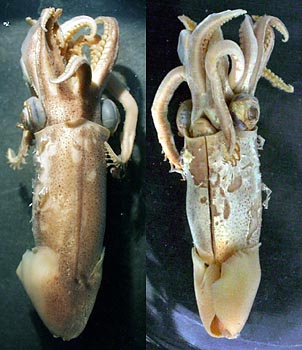
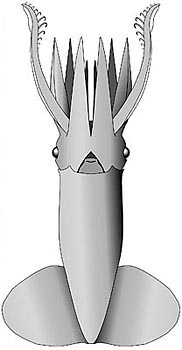
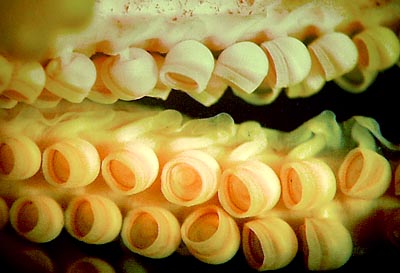
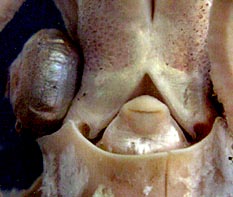
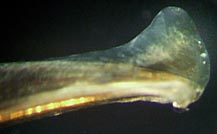




 Go to quick links
Go to quick search
Go to navigation for this section of the ToL site
Go to detailed links for the ToL site
Go to quick links
Go to quick search
Go to navigation for this section of the ToL site
Go to detailed links for the ToL site